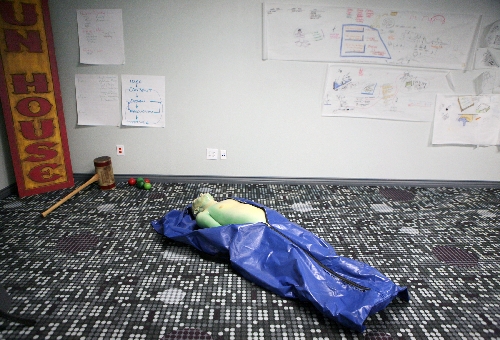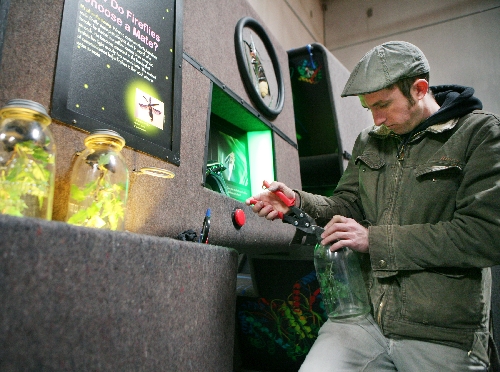Love of science inspires creation of entertaining, educating exhibits
For a science geek, the surprisingly tiny warehouse in southwest Las Vegas surely is one of the coolest places in town.
In one corner, awaiting transport to Delaware, are crates that contain an exhibit about bioluminescence. On the other side of the warehouse, an exhibit about gases is waiting to be packed up and sent off to a science center or museum somewhere else.
The warehouse - which, on other days, might be the temporary home of an exhibit devoted to crime-solving bugs or parasites that prey on humans or the physics of skateboarding - belongs to Exhibit IQ, a Las Vegas-based company that creates traveling and permanent museum exhibits designed to educate and entertain science-shy adults and kids.
Exhibit IQ is the brainchild of John H. Good, its president, who brings to the company experience in marketing and museums, as well as - and, perhaps, most important of all - a lifelong love of science and a passion about persuading others to love it, too.
Good founded Exhibit IQ about a decade ago in Los Angeles. At the time, he was working in communications and marketing and serving as a director of the Natural History Museum of Los Angeles County.
For Good, that museum always has been "kind of a magical museum. It was the museum I had gone to as a kid. I grew up in Orange County, and to be able to work in a place you held so special as a kid was very cool."
As a director, Good was involved in managing the museum's traveling exhibits. But, he says, the museum board "decided to go into a major renovation campaign, and decided to stop the traveling exhibit program."
Good thought it over. He had been working in communications and marketing for about 10 years by then and, he says, "I just got kind of tired of marketing tires and burritos."
So, with a few colleagues, he created Exhibit IQ, which relocated to Las Vegas in 2009. Would Good consider himself, perhaps, a bit of a science geek?
"I hate to admit it, but yes," a smiling Good answers. "I was the kid with the chemistry set and the microscope and the geology stuff - rock tumblers and all that. I was always interested in all of that. My favorite outings were going to museums."
Now, his goal is sharing that love of science by taking the work that scientists do and explaining it to laymen in entertaining, offbeat, compelling ways.
"What I think often is lacking is that a lot of scientists spend their lives focused on their disciplines," Good explains. "And they do amazing work, but they often don't have the background to communicate that with the public."
Exhibit IQ's goal is to "partner with these amazing people and convey what they're working on and their stories and the research they're doing and make it exciting for the public," Good says.
"Really, our goal is to make scientists rock stars. We'd love for them to be as popular as reality shows."
Take, for instance, the Exhibit IQ traveling exhibit "CSI: Crime Scene Insects," which explores the field of forensic entomology, or using insects in the service of crime solving. It's a well-known discipline now, thanks to "CSI," "Bones" and all sorts of TV crime shows. But that wasn't the case back when Good came up with the idea.
"When I was at the Natural History Museum, I went to a lecture by a forensic entomologist, and it was the coolest thing. He had all these gruesome crime scene photos," Good says. "I went up to him and said, 'This would be a great exhibit.' He said, 'You're crazy.'
"This was before the ("CSI) TV show. He was, like, 'Nobody in their right mind is ever going to (visit a museum) to see murders or dead bodies or anything like that.' "
But, ultimately, Good and his staff created an exhibit, which now is one of Exhibit IQ's most popular.
Good says the key to telling a compelling story about science lies in "making those connections with pop culture, because we live in a society where it's hard to get attention for things like science and technology.
"If you say, 'We're going to do an exhibit on physics,' most people's eyes are going to glaze over. If you say, 'We're doing an exhibit on skateboarding with Tony Hawk and, by the way, you might learn a little something about physics,' it's a totally different sell."
Good estimates that about 60 percent of Exhibit IQ's work is creating self-contained exhibits that are leased for limited-run engagements by museums and science centers around the world.
Leasing an Exhibit IQ show offers smaller and midsized museums the chance to offer something that the museum itself might lack the money, resources or expertise to mount by itself. And for museums of any size - Good says Exhibit IQ's clients include the largest and most prestigious museums and science centers in the country - leasing an traveling exhibit gives museum regulars the chance to see something different.
"Once people have come and seen your basic exhibit, what you're displaying on a regular basis, what reason is there to come back?" Good explains. "The whole idea is to change the show. You're offering a new (exhibit) once a year or a couple of times a year and you keep them coming back."
Among Exhibit IQ's clients is the Las Vegas Natural History Museum, which last fall hosted "Tony Hawk Rad Science," a traveling exhibit about the physics of skateboarding featuring Hawk, at the Sahara West Library.
"As a museum, you never want to be static and present the same thing over and over again," says Marilyn Gillespie, the museum's executive director. "So being able to rotate exhibits in and out of the museum is such an asset, and it encourages people to come back to the museum many times and see the new stuff."
Good - who also serves as chairman of the Las Vegas Natural History Museum board of directors and, with the museum, developed the Las Vegas Science Festival - said Exhibit IQ has produced eight traveling shows during the past decade, five of which "are still on the road. We basically produce one new show a year and the older shows get retired."
A traveling exhibit typically takes at least a year to develop and an average of eight months to build, Good says. A typical lease runs about three months, he adds, and rental prices range from about $65,000 to $170,000.
The Tony Hawk exhibit is booked through 2015, Good says, and the ideal is that the costs of creating each exhibit will be recouped over its lifetime.
In addition to traveling exhibits, Exhibit IQ designs permanent exhibits for museums - it helped to design the Las Vegas Natural History Museum's "Treasures of Ancient Egypt" exhibit - and even "entire museums from top to bottom," Good says. "We're renovating a museum in Virginia right now."
The company also is beginning to branch out beyond its focus on science. Good say it's currently working on two exhibits "with a more cultural, rather than scientific slant," about music and tattooing.
For Good, making science more approachable may help to reverse what surveys say is Americans' fading interest in, and knowledge of, science.
"In the '50s, if you looked at the national media, a fair amount of time was devoted to science reporting, and maybe a lot of that had to do with the space race," Good says.
"It's funny that science and technology are increasingly more important in our society, but as a public we've sort of lost interest in it. Maybe people are overwhelmed by it, and we know a lot of people can't relate to it."
And if a museum exhibit helps Americans connect to science, so much the better.
For instance, Good says, "I happen to love insects. I think insects are good teachers, and kids are excited about insects, and they can tell a great story. So, someone says, 'I hate, hate, hate insects.' So you hate butterflies? 'Well ...'
"There's always a way to make a connection with people."
Contact reporter John Przybys at jprzybys@review journal.com or 702-383-0280.























